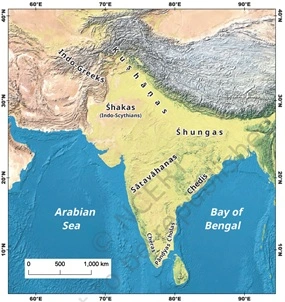
Extra Important Questions With In Text Questions
1. Why is the period that followed the Maurya empire sometimes called the ‘Age of Reorganisation’?
After the Maurya collapse, many new kingdoms emerged.
Regions were reorganized into smaller, competing kingdoms.
Cultural and political structures were rebuilt and adapted.
There was significant internal change along with foreign influences.
2. What were the values or principles that guided emperors of that period?
Protection of all religious sects and schools of thought.
Emphasis on dharma (righteousness) and justice.
Patronage of art, literature, and education.
Promotion of trade, agriculture, and economic prosperity.
3. How did foreign invaders assimilate into Indian society and contribute to cultural confluence?
Adopted Indian religions like Buddhism and Hinduism.
Used local languages and scripts (e.g., Brahmi script on coins).
Indo-Greek, Shaka, and Kushana rulers patronized Indian art and architecture.
Blended Greek and Indian art styles (e.g., Gandhara School).
Additional In Text Questions:
4. What, according to you, could the tradition of using the mother’s name at the beginning of a king’s name signify? (Page 126)
It highlighted the important status of mothers in royal lineage.
Showed respect for maternal heritage and legitimacy.
Possibly emphasized the queen’s role in securing the king’s authority.
5. In the map, you may notice different symbols alongside the names of the kingdoms. What do these symbols represent? (Page 130)
Symbols represented unique emblems or identities of each kingdom.
They highlighted important cultural, political, or economic features.
Helped distinguish one kingdom from another visually.
6. How do historians uncover the trade relations between two distant kingdoms many centuries ago? (Page 133)
Through archaeological evidence like coins, pottery, and shipwrecks.
Inscriptions mentioning trade items, taxes, and merchants.
References in ancient texts (Indian, Greek, Roman records).
Artifacts and materials from one region found in another region.
7. The Pānḍyas were known for their pearls. Why were pearls important for trade during these times?
Pearls were rare and considered luxury items.
High demand among wealthy classes and foreign buyers.
Served as valuable gifts and status symbols in royal courts.
More Questions
8. What might have been the meaning of having deities like Vāsudeva-Kṛiṣhṇa or Lakṣhmī on some Indo-Greek coins?
Signified respect for Indian religious traditions.
Helped Indo-Greek rulers gain acceptance among Indian subjects.
Showed the cultural blending of Greek and Indian beliefs.
9. Do you know where Gāndhāra is? Does it remind you of a character from the epic Mahābhārata?
Gandhara is in present-day Pakistan and Afghanistan.
It reminds us of Gandhari, the queen from Gandhara, mother of the Kauravas in Mahābhārata.
To Learn More In Text Questions Click Below:
Chapter 3- Climates of India
Chapter 4- New Beginnings: Cities and States
Chapter 5-The Rise of Empires
**************************************
MCQs:
Chapter 1- Geographical Diversity of India
Chapter 2- Understanding the Weather
Chapter 3- Climates of India
Chapter 4- New Beginnings: Cities and States
Chapter 5- The Rise of Empires
Chapter 6- The Age of Reorganisation
**************************************
NCERT Solutions:
Chapter 1- Geographical Diversity of India
Chapter 2- Understanding the Weather
Chapter 3- Climates of India
Chapter 4- New Beginnings: Cities and States
Chapter 5–The Rise of Empires
Chapter 6- The Age of Reorganisation
Pingback: InText Questions-The Gupta Era:An Age of Tireless Creativity
Pingback: Chapter 9-From the Rulers to the Ruled:Types of Governments
Pingback: Chapter10 The Constitution of India-An Introduction Class 7
Pingback: In Text Questions-Chapter 11 From Barter to Money-Class 7
Pingback: In Text Questions-Chapter 12-Understanding Markets Class 7